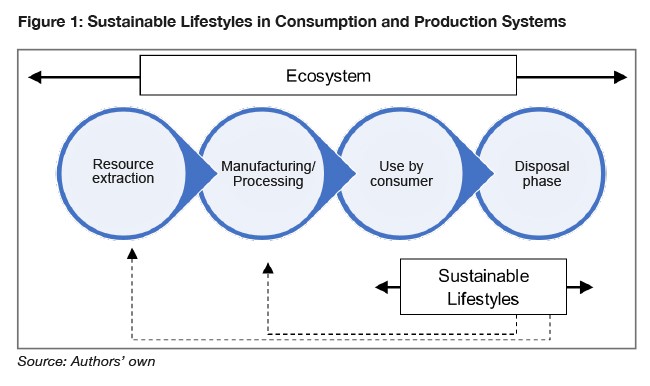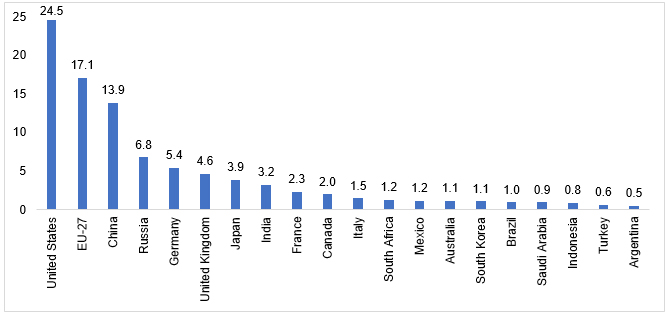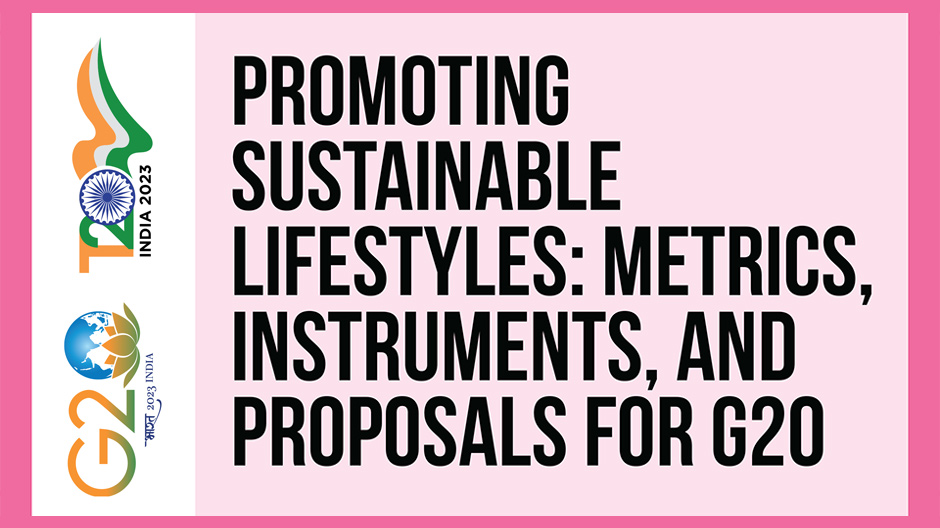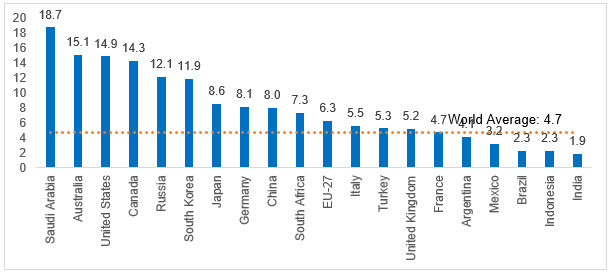TF-3: LiFE, Resilience, and Values for Well-Being
Abstract
The promotion of sustainable lifestyles ought to be seen from the perspective of consumption and production systems and life-cycle approaches that include resource extraction, manufacturing and processing, use by consumers, and disposal. Mainstream frameworks on sustainable consumption and production, including SDG 12, fail to capture downstream segments of resource consumption and production systems especially when it comes to lifestyle choices. This Policy Brief uses a composite index and indices on consumption developed by The Energy and Resources Institute (TERI) in India, to assess the state of lifestyles and consumption in G20 countries and the European Union (EU); these consumption sectors include food, transport, and residential and waste management. The G20 can play a crucial role in promoting norms on sustainable lifestyles as well as informing actions by the use of evidence and exchange of good practices. This Policy Brief recommends the establishment of a ‘lifestyles for environment metrics’ initiative, and for the G20 to launch a global partnership for sustainable lifestyles.
The Challenge: Sustainable Lifestyles in Consumption and Production Systems
Ever since the adoption of Agenda 21 at the United Nations (UN) Conference on Environment and Development in 1992, the global community has given greater attention to the consequences of unsustainable patterns of production and consumption. In 2015, responsible consumption and production was listed as 12th of the 17 Sustainable Development Goals (SDGs). Sustainable consumption and lifestyles need to be seen from the perspective of consumption and production systems that include resource extraction, manufacturing and processing, use by consumers, and disposal (see Figure 1). Broadly, resource value chains consist of upstream and downstream segments. Yet, mainstream frameworks on sustainable consumption and production, including SDG 12, fail to capture downstream segments of resource consumption and production systems especially when it comes to lifestyle choices.

The ‘Lifestyle for the Environment – LiFE Movement’ was introduced by Indian Prime Minister Narendra Modi during the 26th UN Climate Change Conference of the Parties (COP26) in Glasgow in 2021. The idea focuses on “mindful and deliberate utilisation” instead of “mindless and destructive consumption” through advocating sustainable choices (GOI 2022). India’s updated Nationally Determined Contributions (NDCs) of 2022, submitted to the UN Framework Convention on Climate Change (UNFCCC), aims to “put forward and further propagate a healthy and sustainable way of living based on traditions and values of conservation and moderation, including through a mass movement for ‘LiFE’– ‘Lifestyle for Environment’ as a key to combating climate change” (GOI, 2022). According to ‘Mission LiFE’ of the Indian government’s think tank, NITI Aayog, along with policy and regulatory measures to address environmental issues, harnessing the power of collective action is crucial to solve complex problems (NITI, 2022).
According to the Sixth Assessment Report on the Intergovernmental Panel on Climate Change in 2019, approximately 34 percent (20 GtCO2-eq) of total net anthropogenic greenhouse gas (GHG) emissions came from the energy supply sectors, 24 percent (14 GtCO2-eq) from industry, 22 percent (13 GtCO2-eq) from agriculture, forestry and other land use or AFOLU, 15 percent (8.7 GtCO2-eq) from transport, and 6 percent (3.3 GtCO2-eq) from buildings. Much of the emissions come from upstream segments such as industry and power generation.
This makes it more crucial that downstream actions in consumption and production systems—such as lifestyles—lead to changes in upstream segments. Thus, a global LiFE movement cannot be restricted to only individual behaviour change and a critical mass is needed for norms and institutions to transform at a global scale. “Internationalising” LiFE implies collective action by all stakeholders, including governments, intergovernmental organisations, markets, institutions, communities, and individuals.
G20’s Role: Norms and Ecosystems for Promoting Equity and Sustainable Lifestyles
The G20 can play a crucial role in promoting norms on sustainable lifestyles across the globe. So far, G20 discussions, much like those in other international platforms, have focused on resource efficiency and circular economy aspects of sustainable consumption and production systems, and not individual behaviours. In 2022, the G20 Bali Leaders’ Declaration for the first time considered the issue of lifestyles along with resource efficiency and circular economy.
Table 1. Key Developments in G20 On Consumption and Production Systems
| 2017 | G20 Leaders´ Declaration from the Hamburg Summit | G20 Resource Efficiency Dialogue |
| 2019 | The G20 Osaka Leaders’ Declaration | Circular economy, sustainable materials management, the 3Rs (reduce, reuse and recycle) framework |
| 2020 | The Leaders’ Declaration of the G20 Riyadh Summit | Circular Carbon Economy (CCE) Platform and 4Rs (reduce, reuse, recycle, recover) framework |
| 2021 | The G20 Rome Leaders’ Declaration | Circular economy approaches for climate mitigation and adaptation |
| 2022 | G20 Bali Leaders’ Declaration | Lifestyles, resource efficiency and circular economy |
Source: G20 Outcome Documents
The questions of equitable consumption and under-consumption are crucial when considering sustainable lifestyles, given how cumulative and per-capita emissions vary across countries. In the G20, countries like India, Indonesia and Brazil have per-capita CO2 emissions lower than the world average (see Figure 2). Meanwhile, the United States (US), EU-27, and China alone account for more than 55 percent of cumulative GHG emissions (see Figure 3).
Figure 2: Per-Capita CO2 Emissions, 2021 (tonnes per person)
Source: Authors’ own, using data from ourworldindata.org
Figure 3: Cumulative CO₂ Emissions for G20 Countries and EU-27 (billion tonnes), 1850-2020

Source: Authors’ own, using data from ourworldindata.org
In 2022, The Energy and Resources Institute (TERI) in India created a composite index and indices on consumption sectors to assess the state of lifestyles and consumption in G20 countries and the EU; the consumption sectors included food, transport, and residential and waste management (TERI, 2022). Figure 4 is a graphical representation of the index: The higher the score, the lower the consumption is in per-capita terms for the country or entity. The consumption index is prepared based on the following indicators: Total final energy consumption in transport sector (TJ/capita) [Transport]; Meat and dairy production (tonnes/capita) [Food]; Total final energy consumption in residential sector (TJ/capita) [Buildings]; and Plastic waste generation (tonnes/capita) [Waste].
Figure 4 and Table 2: Lifestyles and Consumption Index for G20 Countries and EU, 2022

| Country/ Entity | Meat and dairy production | TFC in transport sector | TFC in residential sector | Plastic waste generation | Sustainable Consumption Index | Sustainable Consumption Index Score |
| India | 1.00 | 1.00 | 1.00 | 1.00 | 1.00 | 100 |
| Indonesia | 0.96 | 0.93 | 1.00 | 0.90 | 0.95 | 95 |
| Mexico | 0.72 | 0.83 | 0.98 | 0.83 | 0.84 | 84 |
| China | 0.69 | 0.92 | 0.85 | 0.77 | 0.81 | 81 |
| Turkey | 0.79 | 0.86 | 0.84 | 0.58 | 0.77 | 77 |
| Japan | 0.86 | 0.75 | 0.75 | 0.67 | 0.76 | 76 |
| South Africa | 0.72 | 0.86 | 0.89 | 0.52 | 0.75 | 75 |
| South Korea | 0.76 | 0.66 | 0.67 | 0.79 | 0.72 | 72 |
| Brazil | 0.26 | 0.82 | 0.99 | 0.68 | 0.69 | 69 |
| European Union | 0.51 | 0.88 | 0.88 | 0.47 | 0.68 | 68 |
| Italy | 0.70 | 0.72 | 0.54 | 0.74 | 0.68 | 68 |
| Saudi Arabia | 0.91 | 0.33 | 0.70 | 0.70 | 0.66 | 66 |
| Argentina | 0.29 | 0.83 | 0.78 | 0.64 | 0.63 | 63 |
| United Kingdom | 0.70 | 0.71 | 0.49 | 0.58 | 0.62 | 62 |
| France | 0.55 | 0.67 | 0.47 | 0.61 | 0.58 | 58 |
| Russia | 0.63 | 0.68 | 0.00 | 0.79 | 0.52 | 52 |
| Australia | 0.00 | 0.32 | 0.65 | 0.79 | 0.44 | 44 |
| Germany | 0.49 | 0.68 | 0.36 | 0.00 | 0.38 | 38 |
| Canada | 0.30 | 0.06 | 0.05 | 0.83 | 0.31 | 31 |
| United States | 0.24 | 0.00 | 0.19 | 0.32 | 0.19 | 19 |
Sources: TERI (2022) [Data Sources Used: Our World in Data (2022), IEA (2022); and Jambeck et al (2015)]
These scores do not indicate the normative direction of lifestyles and consumption patterns, but merely show present levels of consumption. The metrics are also constrained by data availability, especially when it comes to indicators of consumer behaviour.
Developing countries will need the provisioning of basic goods and services for human development and well-being. Thus, international norms need to be promoted considering the twin challenges of equity and sustainable lifestyles.
Four categories of instruments are important in LiFE, sustainable consumption, and just green transitions: international norms, policy instruments, market instruments, and social instruments. These four categories are not mutually exclusive and can have interlinkages with each other.
International Norms: Widely shared expectations about what constitutes appropriate behaviour among governments and non-state actors in international systems. These norms, although based in non-binding frameworks, can lead to cascading effects and policy changes within and across countries and stakeholders.
Policy Instruments: Policy instruments are used by governments when they have a good understanding of the issue as well as the legitimacy to intervene. Policy instruments can include policy frameworks and goals, regulatory and legislative instruments, public finance instruments, making certain standards mandatory, programmatic interventions, procurement, fiscal instruments (taxes and subsidies) and rights-based approaches such as the ‘right to repair’.[a]
Market Instruments: These instruments seek to harness the potential of markets and promote not just the internalising of externalities, but also innovations and business models that drive new products and services, promote responsible waste management, and phase out environmentally harmful products and services. These include responsible advertising, carbon markets, labelling, extended producer responsibility, and new products and services.
Social Instruments: Social instruments aim at awareness generation and capacity building of consumers through the provision of information about a product or a service, such as product qualities and certifications, to influence consumer behaviour. Social instruments also include self-regulating and bottom-up instruments at the individual and community levels—e.g., carpooling.
The G20 can play a crucial role in building norms on sustainable lifestyles as well as informing actions through the other three instruments through the use of evidence and exchange of good practices. Considering the needs of both equity and climate action, through the G20, India can take a leadership role in “internationalising” sustainable lifestyles. The G20 leadership can seek to strengthen collective actions to promote an ecosystem for just, green, and fair transitions.
Recommendations to the G20
For LiFE to thrive and be embedded within just green development transitions, G20 outcomes can build upon three principles:
Principle 1: Promoting internationalisation of sustainable lifestyles rooted in the principles of equity and ‘common but differentiated responsibilities’ and respective capabilities.
Principle 2: Outcomes are premised on collective action approaches using various instruments that promote conducive ecosystems for inclusive and just green transitions through sustainable lifestyles.
Principle 3: Outcomes are based holistically on considerations of consumption and production systems so that sustainable lifestyles lead to innovations in all segments of resource value chains.
This Policy Brief makes the following recommendations to the G20:
Proposal 1: Establish a LiFEMET (Lifestyle for Environment Metrics) Initiative: While many G20 countries are drawing up action plans on resource efficiency and circular economy, it is also important to focus on aspects of sustainable lifestyles and promote sustainable consumption and production. A first step would be to set up an initiative that defines an indicator framework and metrics for equitable and sustainable lifestyles. The TERI lifestyles and consumption index discussed in this brief is an initial step of the advocacy, and more work is needed to establish metrics and instruments for the promotion of lifestyles for sustainable production and consumption.
This initiative necessitates the conduct of empirical studies to help measure consumption patterns. Data can be captured from consumption data collected by not only statistics agencies but also private entities such as market research organisations. There is a need to create a comprehensive experiential database on various types of consumption patterns of goods and services. Metrics need to consider a full system analysis when assessing life-cycle implications of products and services.
When examining GHG emissions or water use in food items, for instance, there is a need to consider energy and water consumption in irrigation, fertiliser production, and other inputs as well. This initiative can also advocate for SDG 12 indicators to include more downstream indicators—especially when it comes to individual consumers—along with instruments such as eco-labels.
Proposal 2: Launch a Global Partnership for Sustainable Lifestyles (GPSL): Such a partnership could serve as a platform for sharing good practices among G20 states and other countries on various policy, social, and market instruments. The platform should be able to engage with G20 as well as other countries to forge multistakeholder engagement with consumer groups, governments, youth, research institutions, and the private sector. The latter includes advertising, as emphasis needs to be placed on responsible advertising and public awareness campaigns in the space dominated by commercial advertisements. The role of traditional knowledge is also crucial.
Good practices on waste management, supply chain reforms, public campaigns and rights-based instruments can be shared and documented. Good practices in waste management can be shared—for instance, measures such as extended producer responsibility—a policy tool anchored in lifecycle approaches wherein producers take responsibility to dispose of or recycle a product. Lessons can be gleaned from the experience of South Korea, which launched its volume-based waste fee (VBWF) system in 1995, where residents are charged waste disposal fees based on the amount of waste they dispose of (MOEK 2003). In Alappuzha, Kerala, the urban local body has been implementing the ‘Clean Homes, Clean City’ project since 2012, promoting the segregation and treatment of wet waste at the source (Agarwal 2017). Meanwhile, the ‘Good Green Deeds’ campaign in South Africa seeks to change people’s attitudes and behaviours towards responsible management of waste and keeping their neighbourhoods clean, green and safe (DOEA 2019).
In India, the Department of Consumer Affairs announced the development of a comprehensive framework on the ‘right to repair’ (DOCA 2022). The 9R framework used in the Global Environment Outlook could be a good entry point for engagement with not only consumers but also industry stakeholders and policymakers (UNEP 2019). The notion of ‘9Rs’ refers to refuse, rethink (design), reduce, re-use, repair, refurbish, remanufacture, repurpose, recycle, and recover.
G20 can further advocate for the internationalisation of lifestyles through the UN General Assembly, for example through a mandating report by the UN Secretary General. Equitable and sustainable lifestyles could also be considered as a theme for the High-level Political Forum – Sustainable Development Goals. From a Global South perspective, when discussing lifestyles, climate change adaptation and mitigation needs to be considered. Under the UNFCCC, the Subsidiary Body for Scientific and Technological Advice (SBSTA) can be given a mandate to produce technical reports on adaptation and mitigation lifestyles.
A critical mass of support from various stakeholders is required for norms and institutions to change. Along with stakeholder support, evidence of best practices and adequate data is needed for informed international norms as well as policies and practices within countries. G20 can take the lead in internationalising sustainable lifestyles for the environment.
Bibliography
Agarwal, R. “Alappuzha Gets Recognised by UNEP for its Solid Waste Management Practices.” Down to Earth, November 30, 2017.
DOCA. “Department of Consumer Affairs Sets Up Committee to Develop Comprehensive Framework on the Right to Repair.” July 14, 2022.
DOEA. Good Green Deeds Booklet. Pretoria: Department of Environmental Affairs, Republic of Korea, 2019.
GOI. India’s Updated First Nationally Determined Contribution under Paris Agreement (2021-2030), Submission to UNFCCC (United Nations Framework Convention on Climate Change). New Delhi: Government of India, 2022.
IEA. World Energy Balances. Paris: International Energy Agency, 2022.
IPCC. Climate Change 2022: Mitigation of Climate Change. Contribution of Working Group III to the Sixth Assessment Report of the Intergovernmental Panel on Climate Change. Cambridge and New York: Cambridge University Press, 2022.
Jambeck, Jenna R., Roland Geyer, Chris Wilcox, Theodore R. Siegler, Miriam Perryman, Anthony Andrady, Ramani Narayan, and Kara Lavender Law. “Plastic Waste Inputs from Land into the Ocean.” Science 347, no. 6223 (2015): 768-71.
MOEK. Volume-Based Waste Fee System: Korea Environmental Policy Bulletin. Seoul: Ministry of Environment Korea and Korea Environment Institute, 2022.
NITI. Mission Document for LiFE (Lifestyle for Environment). New Delhi: NITI Aayog, 2022.
Our World in Data, “Meat Production,” 2022, accessed 12 January, 2023.
TERI. Internationalizing Lifestyles and Sustainable Consumption: Implications for G20. The Energy and Resources Institute. New Delhi: The Energy and Resources Institute, 2022.
UNEP. Sixth Global Environment Outlook. Nairobi: United Nations Environment Programme, 2019.
[a] The ‘right to repair’ refers to a government legislation that is intended to allow consumers the freedom to have their own consumer electronic devices repaired or modified, where otherwise/previously the manufacturers of such devices require the consumer to use only their offered services. Many product manufacturers have monopoly on repair processes which infringes on the customer’s ‘right to choose’. Due to planned obsolescence, manufacturers design a product with a limited life, and this leads to increased waste (including e-waste) and forces consumers to spend more to buy new products. To enable repair, manufacturers are also required to provide complete knowledge and access to manuals, schematics, and software updates (DOCA 2022).






